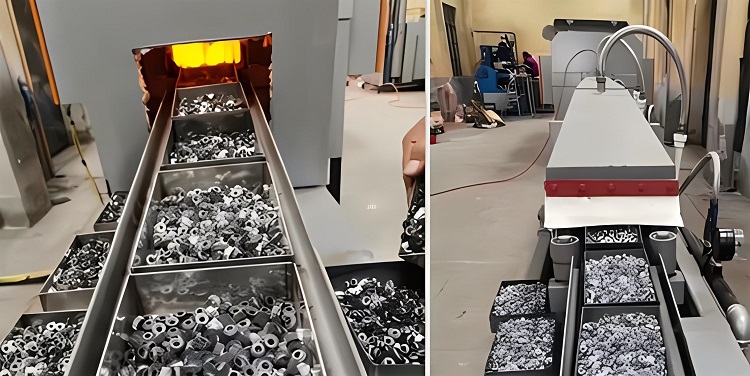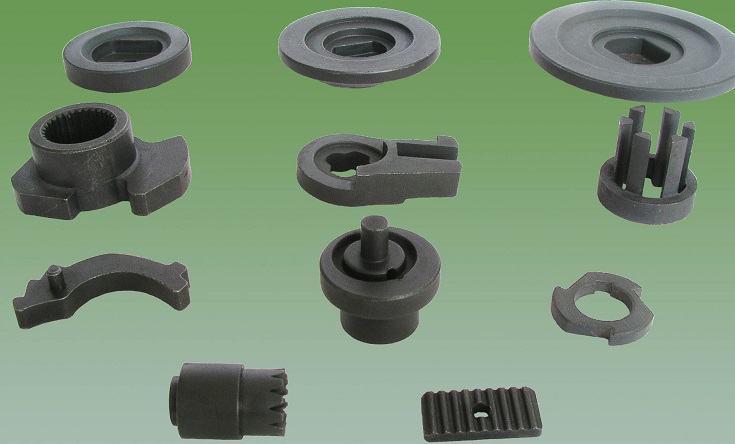Powder metallurgy sintering: technological development and industrial applications
Powder metallurgy sintering, a time-honored but continuously innovative metal processing technology, has been widely used in a variety of industrial fields. This technology uses powdered metal raw materials to form metal products with the desired shape and properties through a molding and sintering process.
The basic principle of powder metallurgy sintering is to form a solid metal with a certain strength and density through the process of diffusion and recrystallization between particles under a specific temperature and pressure. The advantage of this process is that it can produce metal parts with complex shapes that are difficult to obtain through traditional casting methods, while also reducing material waste and improving material utilization.
In recent years, with the progress of science and technology, powder metallurgy sintering technology is also developing. Among them, the most significant is the emergence of new sintering processes, such as microwave sintering, discharge plasma sintering, and so on. These new processes can not only increase the sintering speed and reduce the sintering temperature but also refine the microstructure of the material and improve the performance of the product.
In industrial applications, powder metallurgy sintering technology is widely used in automotive, aerospace, electronics, medical and other fields. For example, some key components of automotive engines, such as turbocharger rotors, fuel injectors, etc., can be manufactured by powder metallurgy sintering technology. These components are not only light in weight, high in strength but also have good wear resistance and heat resistance, which plays an important role in improving the fuel efficiency and power performance of automobiles.

Importance of sintered powder metallurgy
1) Sintering is one of the indispensable basic processes in powder metallurgy production (except for magnetic core and bonded magnetic materials)
2) Sintering has a decisive effect on the performance of PM products (sintering waste is difficult to remedy, such as the decarburization of iron base parts and serious sintering deformation)
3) Sintering consumption is an important part of the cost of powder metallurgy products (equipment, high temperature, long time, protective atmosphere).
4) The acquisition of nano-bulk materials depends on the control of the sintering process.
Sintered Powder metallurgy materials
| 1 | PM2000 | Fe: 90%, C: 5%, Si: 5% | D50: 50 | 1150 | 60 | 98.5 | 1.5 | UTS: 1200 MPa, YS: 900 MPa, Elongation: 15% | Density: 7.8 g/cm³, Thermal Conductivity: 20 W/m·K | Automotive parts, gears, bearings |
| 2 | Cu-10Sn | Cu: 90%, Sn: 10% | D50: 30 | 900 | 45 | 97.0 | 3.0 | UTS: 400 MPa, YS: 200 MPa, Elongation: 30% | Density: 8.5 g/cm³, Electrical Conductivity: 30% IACS | Electrical contacts, terminals |
| 3 | Al-5Si | Al: 95%, Si: 5% | D50: 45 | 600 | 90 | 96.0 | 4.0 | UTS: 250 MPa, YS: 150 MPa, Elongation: 10% | Density: 2.7 g/cm³, Thermal Conductivity: 200 W/m·K | Automotive heat exchangers, engine parts |
| 4 | WC-Co | WC: 92%, Co: 8% | D50: 1.5 | 1350 | 120 | 99.0 | 1.0 | Vickers Hardness: 2000 HV, Fracture Toughness: 12 MPa·m² | Density: 15.5 g/cm³, Thermal Conductivity: 10 W/m·K | Cutting tools, wear parts |
| 5 | Ti-6Al-4V | Ti: 90%, Al: 6%, V: 4% | D50: 60 | 1300 | 90 | 97.5 | 2.5 | UTS: 1000 MPa, YS: 850 MPa, Elongation: 10% | Density: 4.5 g/cm³, Thermal Conductivity: 10 W/m·K | Aerospace components, medical implants |

How does powder metallurgy sintering technology improve the performance of metal products
Powder metallurgy sintering technology plays an important role in improving the performance of metal products, mainly reflected in the following aspects:
- Densification improves strength
Powder metallurgy sintering technology can achieve the best densification effect in the sintering process by precisely controlling the sintering parameters and optimizing the sintering process, so as to improve the strength of metal products. By reducing the pores and defects inside the product, the overall strength and service life of the metal product are improved.
- Homogenize the organization
Powder metallurgy sintering technology can make the metal powder form a uniform structure in the sintering process, eliminating the phenomenon of composition segregation that may appear in the traditional casting method. Uniform structure is beneficial to improve mechanical properties and corrosion resistance of metal products.
- Refine grain
Powder metallurgy sintering technology can effectively refine the grain size of metal products by controlling the sintering temperature and sintering time. Fine grain can improve the mechanical properties and toughness of metal products so that they have better impact resistance and fatigue resistance.
- Control impurity distribution
Powder metallurgy sintering technology can effectively control the content and distribution of impurity elements by selecting high-purity raw materials and precise preparation process when preparing metal powder.
New process of powder metallurgy sintering technology
Powder metallurgy sintering technology is an important material processing technology, which is widely used in the manufacture of various high-performance and high-complexity metal parts. In recent years, with the progress of science and technology, powder metallurgy sintering technology is also constantly innovating and developing, and many new processes have emerged. Eight of these new processes are described in detail below.
- Warm forming technology:
Warm pressing technology is introduced in powder metallurgy, by controlling the forming temperature and pressure of powder, improving the forming performance and density of powder. This technology can effectively reduce the void in the powder and improve the density and mechanical properties of the parts.
- Flow temperature and pressure technology:
Flow thermobaric technology is developed on the basis of thermobaric technology, by adding a specific lubricant to the powder, so that the powder has better flow during the forming process. This technology can further improve the forming accuracy and surface quality of the parts.
- Rapid condensation atomization powder:
The rapid condensation atomization technology is a new powder preparation technology. The molten metal liquid is broken into fine powder particles by high-speed air flow. The powder prepared by this method has fine grain and uniform chemical composition, which is helpful in improving the performance of sintered parts.
- Mechanical alloying powder:
Mechanical alloying technology is the use of high-energy ball mill powder of different components to mix and fine, through the action of mechanical forces to achieve powder alloying. This method can prepare high-performance alloy powder, which provides the possibility for sintering parts with complex structures.
- Preparation of ultrafine powder or nanopowder:
The preparation technology of ultrafine powder or nanopowder is to prepare powder with particle size at the nanometer level by physical or chemical method. This powder has a very high specific surface area and activity, which can significantly improve the mechanical properties, electromagnetic properties, and thermal properties of sintered parts.
- Sol-gel technology:
Sol-gel technology is a powder preparation method based on a chemical reaction, by converting metal ions into sol in solution, and then through the steps of gelation, drying, and calcination, the required powder is obtained. The powder prepared by this technology has high purity and good uniformity and is suitable for the preparation of high-performance ceramics and composite materials.
- Powder injection molding technology:
Powder injection molding technology mixes the powder with the organic binder and prepares the green body with a complex shape through the injection molding mechanism. This method can realize near-net forming of parts, reduce subsequent processing, and improve production efficiency.
- Powder plasticizing extrusion technology:
Powder plasticizing extrusion technology is to add plasticizer to the powder to make the powder have better plasticity in the extrusion process. By controlling the extrusion temperature and pressure, the powder can be densified and formed. This technology is suitable for manufacturing metal parts with high strength and high-density requirements.
With the continuous emergence of new materials and new processes, powder metallurgy sintering technology will continue to develop in the direction of higher performance and higher efficiency, providing strong support for the upgrading of the manufacturing industry.
More resources
WHO WE SERVE | Gear Manufacturing | MIM-Technology | Products


